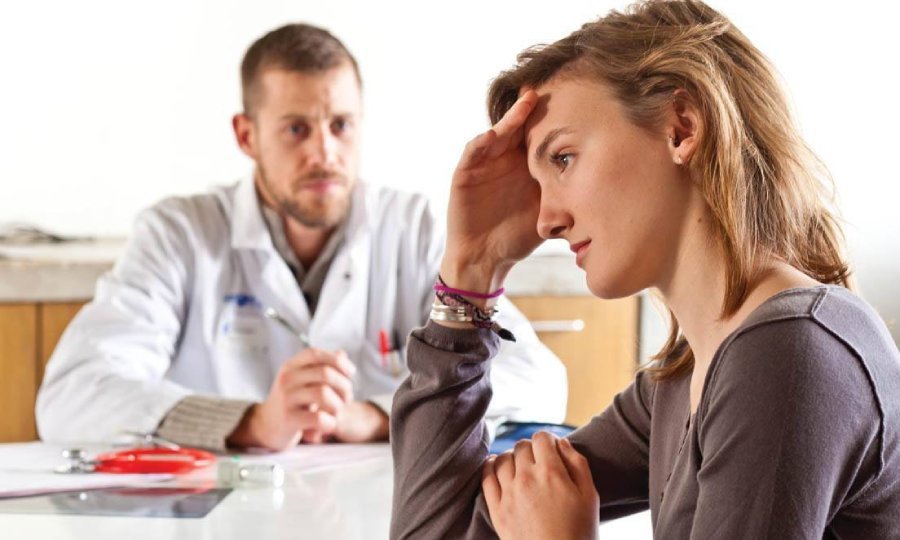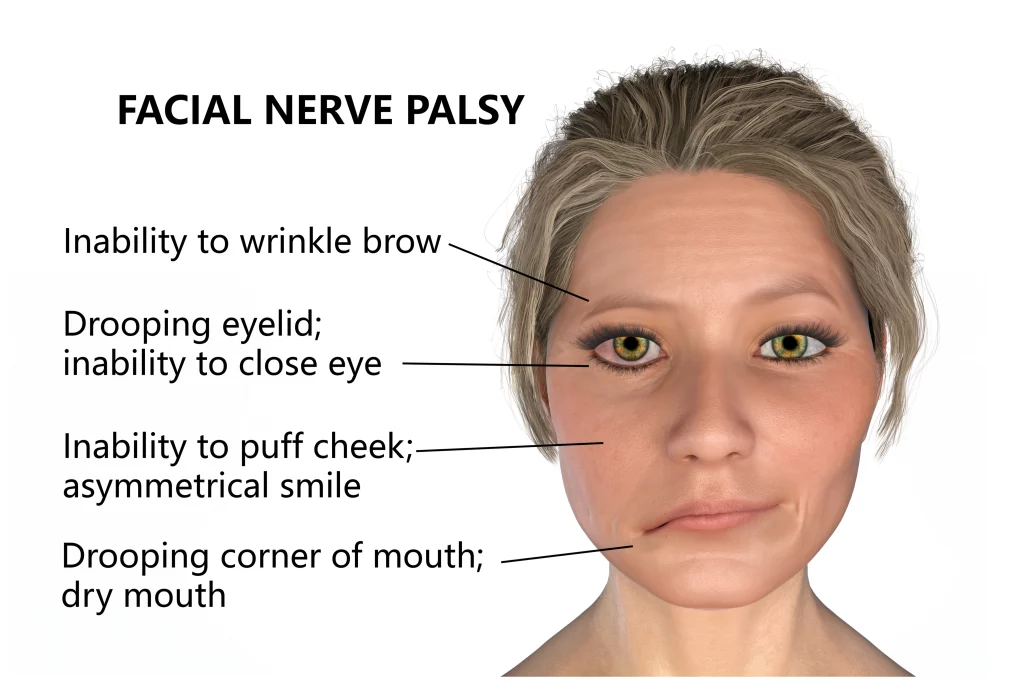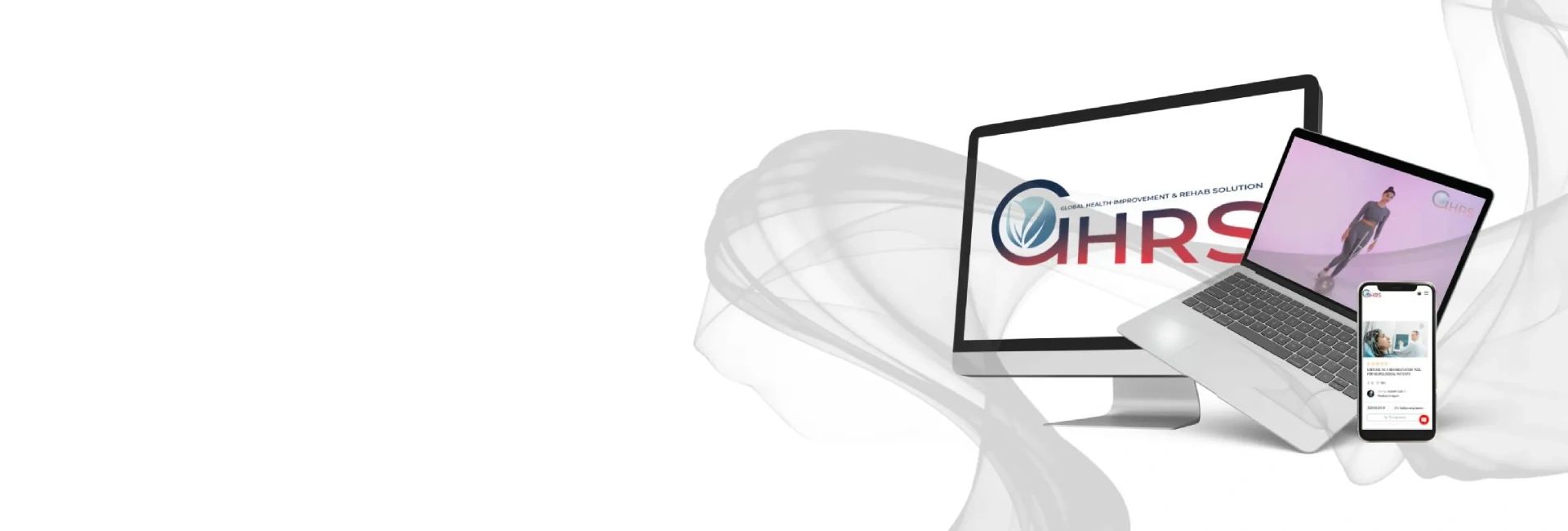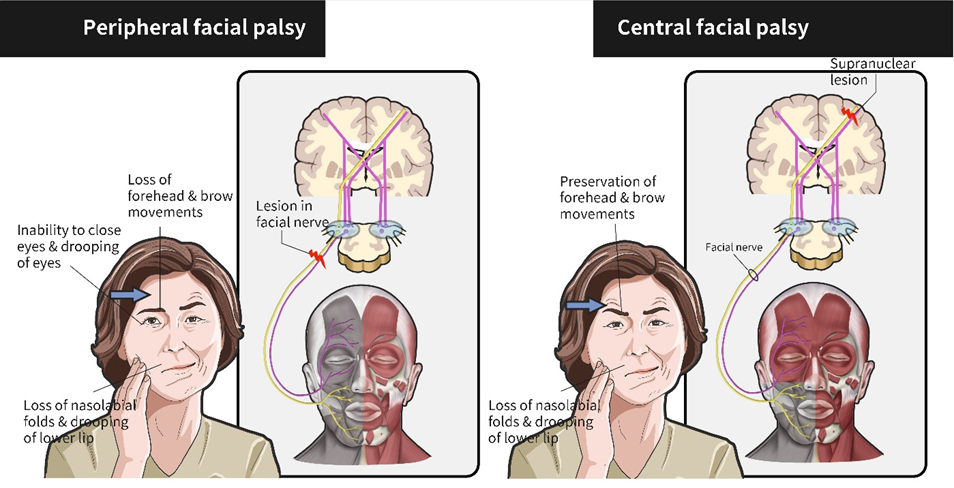Facial nerve paralysis, Bell’s palsy is a sudden weakness or paralysis of the muscles from one side of the face due to damage to the facial nerve (the seventh cranial nerve). This nerve innervates and manages the mimic muscles of the face, the salivary and lacrimal glands, transmits taste information perceived by the anterior 2/3 of the tongue to the brain, and manages the muscle of the middle ear.
Neuritis or neuropathy of the facial nerve appears as a result of inflammation or swelling of the nerve, the main signs of which can appear immediately or after a few days. The main manifestations of facial neuritis – half of the face looks skewed, the smile is twisted, in some cases, eyes do not close completely. The disease occurs frequently after the age of 40, in men and women equally.
In Bell’s palsy, the first symptom may be pain behind the ear. Weakness of the facial muscles appears suddenly, usually within a few hours. In different patients, weakness varies from slight to complete paralysis. Weakness increases within 48–72 hours and then does not enhance. The damage extends only to half of the face. With paralysis of the facial nerve, the face becomes lifeless and expressionless. Most patients feel that their face is numb or heavy, even though the sensitivity is not affected by this disease. The incidence is about 25 cases per 100 thousand population per year. The treatment of neuralgia of the facial nerve is carried out by a neurologist, but due to complexity of determination of additional causes of the disease development, it is recommended to consult with both an ophthalmologist and ENT specialist.

What are the main symptoms and clinical manifestations of facial nerve paralysis?
Typical external symptoms
Most noticeable is that part of the face seems to sag, the eye on the affected side is enlarged, reddened and watery. Pronounced weakness of facial muscles from the very beginning, with speech and movements that are usually expressed on the face (facial expression), their absence is evident. The disease deprives a person of the opportunity to control his face and show emotions: frown, smile, raise his eyebrows in surprise, and even chew food normally. The face at the same time looks asymmetrical and skewed. The side of the face not affected by paralysis appears distorted against the background of the lack of movement of the paralyzed side.
Symptoms noticeable to patients
Other symptoms that are more noticeable to patients themselves. You have to make more effort to articulate, and due to that, speech becomes slurred and blurry. When eating, pieces remain under the paralyzed cheek, so a patient has to move the tongue to get them into the oral cavity with. Often, a patient with this disorder has the mouth not completely closed, so part of the liquid goes from the oral cavity uncontrollably, there is a unilateral impairment of taste sensations in the anterior 2/3 of the tongue, there may be a distorted, unpleasantly enhanced perception of sounds from the side involved. Also, in half of the cases, the disease begins with pain behind the ear, which can sometimes radiate to the back of the head or face, aching and burning pains.
The most unpleasant symptom
The most unpleasant symptom is an eyelid that does not close completely, which can lead to chronic inflammation of the mucous membrane of the eye, as well as damage to the cornea, which subsequently requires immediate surgical treatment. Eating problems, impaired emotional communication lead to the fact that the patient tries to avoid social life and becomes withdrawn.
The most common causes of the disease are:
In 75% of cases, the cause remains unknown (idiopathic facial neuropathy or Bell’s palsy);
Infection factor
Infection by Herpes virus, which lives in the body of most people and does not show its presence. But when immunity decreases, the virus actively multiplies, causing the nerve inflammation and swelling;
Hypothermia
Hypothermia, in the case of neuritis of the facial nerve, local hypothermia (draft, air conditioning) is especially dangerous. In this case, a spasm of blood vessels and muscles occurs, which contributes to the nerve malnutrition and inflammation;
Brain mass lesions
Brain injuries, head contusions, falls, accidents
Among patients with Bell’s palsy, the high percentage is patients with diabetes mellitus, and people with arterial hypertension are also common.
Classification and stages of development of facial nerve paresis (paralysis)
They can be classified by the two main types:
Depending on the cause
Depending on the cause, the disease is divided into primary neuropathy of the facial nerve (idiopathic neuropathy of the facial nerve, Bell’s palsy) and secondary neuropathy (with herpes infection – herpes simplex, herpes zoster), tumors, injury and other processes).
There are three periods of the course of facial nerve neuropathy:
-
acute period – the first month from the onset of the disease;
-
subacute period – recovery is delayed by more than 1-1.5 months;
-
residual effects and complications.
in accordance with the period of the disease, the correct choice of the method of treatment and rehabilitation is of importanve (for example, drug therapy, therapeutic exercises, physiotherapy, surgery, etc).
The second type of classification:
There are central and peripheral paresis (paralysis) of the facial nerve.
Central paresis is a consequence of a lesion of the central nervous system, as, for example, in a stroke, and differs causing muscle weakness only in the lower part of the face (smoothness of the nasolabial fold, drooping of the mouth corner, etc.), and the upper one remains intact.
In all cases of peripheral lesion, mimic muscles of the face suffer: there is a unilateral decrease or loss of strength of the mimic muscles of the face. The patient on the involved side has a reduced number of folds on the forehead, limited mobility of the eyebrow, the eye does not close completely, and when closing the eyeball moves up (Bell’s symptom), the nasolabial fold is smoothed, the cheek “floats” when inflated, it is impossible to whistle, the liquid pours out of the mouth, does not participate in the movement of the subcutaneous neck muscle.
Residual effects and complications
It is important to mention such a phenomenon as Synkinesia (involuntary muscle contractions, tics), which is a late complication. spasmoparesis of facial muscles and the syndrome of “crocodile tears” (lacrimation while eating) can also be attributed to the group of late complications.
There is an opinion that spasmoparesis and synkinesia arise as a result of improper patient management, for example, an early and intensive start of exercises for facial muscles, and improper prescription of drug therapy. Therefore, it is very important to carry out treatment under the supervision of an experienced physician and a physiotherapist.
Treatment of facial nerve paralysis (paresis)
The objectives of treatment are aimed at the rapid restoration of nerve and muscle function, as well as the prevention of complications. Treatment should begin as early as possible. Therefore, it is recommended to initiate immediately steroid therapy. With idiopathic neuropathy, a short course of glucocorticoids in high doses is traditionally used in the treatment. Timely treatment with glucocorticoids increases the frequency of complete functional recovery by 17%.
Approximately in 2/3 cases, especially at a young age, there is a complete recovery of functions. In 13% of cases, minimal residual symptoms persist, 16% of patients have incomplete recovery, spasmoparesis and synkinesis develop.
In 70% of cases, facialis resolves spontaneously within about 6 weeks. When taking steroids, the chances of recovery increase up to 85%. 15% of patients experience slower rehabilitation and definitely require neuromuscular rehabilitation of the facial muscles.
As for non-drug treatment, physiotherapy and mimic gymnastics, massage and reflexology are used.
Video: “Rehabilitation of the patients with Facial nerve paralysis | Bell’s palsy”
FACIAL NERVE PARALYSIS. SET №1 FOR THE UPPER PART OF THE FACE: FOREHEAD, EYEBROWS, EYES, NOSE, BRIDGE OF THE NOSE
For additional information about Rehabilitation of the patients with Facial nerve paralysis | Bell’s palsy you can watch a video demonstrating exercises and rehabilitation recommendations.
Advices from physiotherapists and rehabilitators for treating Bell’s palsy:
Main question
When to start rehabilitation of facial paralysis?
The new recommendations for the treatment of Bell’s palsy are to start treatment after about 6-10 weeks. But the experience and clinical studies show that the recovery process should begin soon after the initial spontaneous and natural improvements appear. This means that physiotherapeutic procedures and exercises should be done after the first movements appear on the face.
It is recommended from the very beginning to develop an individual program of initial exercises and movements in order to achieve the best results of rehabilitation.
Practical advices
-
Seek immediate medical attention if you suspect facial paralysis
-
Initial treatment – steroids
-
Maintain good oral hygiene. Food debris can accumulate in the gums
-
Be sure to close your eyes at night. If the eye is open, it may dry out. In addition, the body tries to close the eye, and for this it compresses the cheek up, and this may increase the phenomenon of synkinesis in the future.
-
Use eye drops to keep moisture
-
Drink through a straw if you feel that the liquid has spilled. Drinking through a straw is also a great facial exercise.
-
Do not give up and despair! There are cases when, even years after the onset of facialis, results can still be achieved with the help of physiotherapy, therapeutic exercises and special exercises.

CHECK OUT THE DEMO VERSION OF OUR SETS OF EXERCISES FOR Facial nerve paralysis | Bell’s palsy ON YOUTUBE
Our website presents the following sets of exercises for the rehabilitation of the patients with Facial nerve paralysis | Bell’s palsy:



